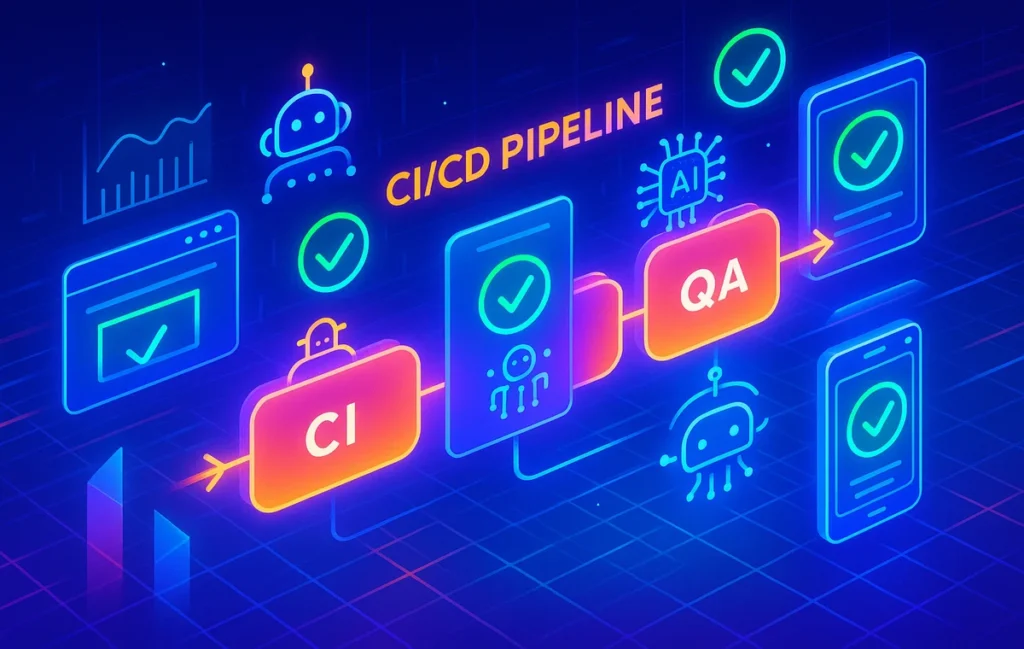🚀 Why “QA at Speed” Defines 2025
The pressure to release software faster has never been higher. With agile sprints shrinking, customer expectations soaring, and deployment cycles hitting multiple releases per day, quality assurance (QA) has become the linchpin of success. In 2025, QA isn’t a separate phase tacked onto development—it’s woven into continuous integration and continuous delivery (CI/CD) pipelines.
Developers can no longer afford week-long manual testing cycles. Every commit must trigger automated validation to catch bugs before they snowball into production. Enterprises adopting this “QA at speed” mindset are seeing deployment failure rates drop by as much as 40%, according to recent DevOps surveys.
💡 Nerd Tip: Think of QA in 2025 not as a gatekeeper, but as a safety net woven into your pipeline. The faster you can trust your tests, the faster you can deliver value.
If you’ve been exploring Workflow Automation 101 or experimenting with Build AI Workflows Without Code, QA automation is a natural next step in your automation journey.
🛠️ Core CI/CD-Ready Testing Tools
The modern QA toolkit goes far beyond “record and play” test cases. The best platforms combine developer-friendly scripting, seamless CI/CD integrations, and scalable cloud testing environments.
Selenium remains the workhorse, powering millions of browser automation suites worldwide. Its open-source flexibility makes it the default for enterprises, though its setup can feel heavy for fast-moving teams. Cypress emerged as the developer darling, offering quick setup, JavaScript-native syntax, and real-time debugging. Playwright, developed by Microsoft, adds powerful cross-browser automation with parallel execution baked in.
On the SaaS side, tools like Testim leverage AI for test maintenance, automatically healing flaky tests as code evolves. Katalon offers an accessible UI-driven experience for teams bridging manual and automated testing. BrowserStack and LambdaTest bring the power of cloud-hosted browsers and devices, letting teams validate across thousands of environments without managing local infrastructure.
💡 Nerd Tip: Match your tool to your release velocity. A startup pushing daily builds may prioritize ease of setup (Cypress, Playwright), while an enterprise juggling complex workflows may lean on Selenium or BrowserStack.
🔗 Why QA Speed Matters for Agile & CI/CD
In agile development, speed without quality is chaos. A failed deployment doesn’t just waste developer hours; it erodes customer trust and can trigger expensive rollbacks. That’s why QA automation tied directly into CI/CD pipelines is no longer optional.
When a developer pushes a commit to GitHub, tools like Jenkins or GitHub Actions can instantly trigger automated test suites across browsers, devices, and APIs. This creates a feedback loop measured in minutes, not days. High-performing teams now ship features multiple times a day, with confidence backed by robust testing.
The business case is equally clear. A Forrester study in late 2024 found that teams with strong CI/CD-driven QA reduced time-to-market by 23% while slashing bug-related rework costs by 30%. This kind of ROI mirrors trends we’ve seen in Top 10 Automation Tools for Marketers, where faster iteration cycles consistently compound into higher growth.
💡 Nerd Tip: Embed QA earlier. The longer a bug survives in your pipeline, the more expensive it becomes to fix—sometimes by an order of magnitude.
📊 CI/CD Comparison Matrix
| Tool | Language Support | CI/CD Integration (Jenkins, GitHub, etc.) | Cloud Testing | Pricing (per month) |
|---|---|---|---|---|
| Selenium | Java, C#, Python, JS, more | Strong (Jenkins, GitHub Actions, CircleCI) | Via add-ons | Free (infra costs apply) |
| Cypress | JavaScript, TypeScript | Native GitHub Actions, Jenkins plugins | Limited | Free + $75/team plans |
| Playwright | JavaScript, Python, .NET, Java | Strong CI/CD integrations, parallel tests | Yes (via Azure/3rd-party) | Free + managed services |
| Testim | JavaScript | CI/CD APIs and plugins | Cloud-native | From $450/team |
| Katalon | Java/Groovy, Keyword-driven | Jenkins, GitLab, Bamboo | Cloud + Desktop | From $25/user |
| BrowserStack | Multiple via Selenium | Deep CI/CD hooks across platforms | Yes, 3,000+ browsers | From $39/user |
| LambdaTest | Selenium + Playwright | Jenkins, GitHub, Azure DevOps | Yes, 3,000+ browsers | From $15/user |
💡 Nerd Tip: Don’t just pick based on features—calculate the “cost per validated build.” A pricier platform that saves you 10 failed deployments pays for itself instantly.
⚡ Ready to Automate Your QA?
Explore tools like Cypress, Playwright, and BrowserStack to accelerate your CI/CD pipelines. Ship faster with confidence and fewer rollbacks.
⏩ Shift-Left Testing & Developer Ownership
One of the defining movements in QA for 2025 is the shift-left mindset. Instead of waiting until the end of a sprint to run automated test suites, teams are embedding testing earlier—at the moment code is written or reviewed. This shift not only catches bugs sooner but also distributes quality ownership across the development team instead of placing the burden solely on QA engineers.
Studies show that the cost of fixing a defect grows exponentially as it moves through the lifecycle: what costs $100 to fix during coding may balloon to $1,500 after production release. By empowering developers to write unit tests, run pull-request validations, and automate integration checks right from their IDEs, teams cut downstream costs dramatically.
💡 Nerd Tip: Shift-left doesn’t mean removing QA teams—it means giving developers more responsibility for quality. The result is fewer late-stage surprises and a healthier, more collaborative pipeline.
📈 Performance & Load Testing in CI/CD
Functional tests ensure features work as intended, but in 2025, performance testing is just as critical. A release that passes all UI checks but collapses under real-world traffic can be more damaging than a functional bug. That’s why forward-thinking teams now weave load testing tools such as JMeter or k6 directly into their CI/CD pipelines.
Instead of waiting for quarterly stress tests, every major release can be validated for throughput, latency, and scalability. Cloud platforms like LambdaTest are even starting to offer performance testing grids, allowing distributed load generation across geographies. For high-growth startups and global enterprises, this ensures that customer experiences remain consistent even as user counts spike.
💡 Nerd Tip: Treat performance metrics as part of your definition of done. If a build can’t handle expected concurrency, it isn’t ready—no matter how bug-free it looks.
🌀 Flaky Tests & Test Debt
Fast-moving pipelines often hit a silent killer: flaky tests. These are tests that sometimes pass and sometimes fail, without code changes in between. While each false failure may seem minor, they erode trust in automation, slow down deployments, and lead to “test debt”—suites that teams silently ignore because results aren’t reliable.
Modern solutions include retry logic, better isolation of test environments, and self-healing mechanisms powered by AI. Platforms like Testim detect patterns in flakiness and automatically repair scripts, while Playwright and Cypress provide clearer debugging to reduce false negatives. Parallel test execution also helps minimize environmental inconsistencies.
💡 Nerd Tip: Never let flaky tests accumulate. Treat them like broken windows—fix immediately or risk losing confidence in the entire QA pipeline.
🤝 Integration with DevOps Culture
QA automation is not just about tools—it’s about culture. In many organizations, QA was once a separate department, seen as the “final checkpoint” before release. In the DevOps era, that silo has disappeared. Developers, testers, and operations staff all share ownership of quality and uptime.
This integration demands transparency. Dashboards from Jenkins, GitHub Actions, or BrowserStack shouldn’t live only with QA teams—they should be visible across the organization. Daily standups in high-performing teams now review not just user stories but also build health, test coverage, and failure trends.
💡 Nerd Tip: Invest as much in cultural alignment as in tooling. A developer who feels responsible for green pipelines is more valuable than any plug-in or framework.
🔮 The Future of QA: AI Test Generation & Predictive QA
Looking ahead, the next frontier of automated QA is AI-powered testing. Already, platforms are experimenting with AI to auto-generate test cases from user stories, reducing the manual effort of scripting. Imagine committing a new feature description, and the system instantly generating dozens of relevant test cases in Selenium or Playwright.
Beyond generation, AI is also moving into predictive QA. By analyzing historical bug data, commit history, and developer behavior, AI models can forecast which areas of code are most likely to break. This proactive testing shifts QA from reactive to predictive, saving teams from costly regressions. Blockchain-backed audit trails may also play a role, ensuring test results are immutable and trusted across distributed teams.
💡 Nerd Tip: Even if you’re not ready to adopt AI-driven testing today, keep an eye on vendors experimenting with it. Early adopters often gain speed and coverage advantages that lagging teams struggle to catch up with.
📬 Want More Smart Workflow Insights?
Join our free newsletter and get weekly updates on automation, DevOps tools, and AI workflows—straight from the NerdChips playbook.
🔐 100% privacy. No noise. Just actionable insights for builders and teams.
🧠 Nerd Verdict
Automation testing is no longer about “catching bugs”—it’s about enabling velocity. In 2025, the winners will be teams that blend developer-friendly frameworks like Cypress and Playwright with scalable cloud grids from BrowserStack and LambdaTest. Enterprises with complex workflows will continue to rely on Selenium and Katalon, while AI-driven platforms like Testim push toward self-healing tests.
The common thread? QA at speed. Your pipeline is only as fast as the confidence you have in its output. Without automated tests woven into CI/CD, every deployment is a gamble. With them, every deployment becomes a growth engine.
❓ Nerds Ask, We Answer
💬 Would You Bite?
If your team could eliminate 80% of post-deployment bugs by investing in faster automated QA, would you prioritize it today—or wait until a failure costs you more?
Crafted by NerdChips for creators and teams who want their best ideas to travel the world.



